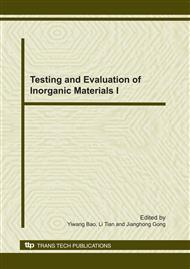p.105
p.109
p.114
p.118
p.121
p.125
p.129
p.132
p.136
Wear Behaviors of TiCN Cermet under Different Concentrations of Abrasive Slurries from Carborundum, Corundum and Silica Sands
Abstract:
Through a modified ASTM B611 wet sand rubber rimmed wheel test system (model: MLS-225), the wear resistance of commercially bought TiCN cermets FD22 was studied with water-based slurries of abrasive sands. The applied abrasives were angular sands of carborundum, corundum, and silica with particle size of about 350 μm. During experiments, the rotation speed of the rubber wheel was fixed at 498 rpm, and the load was 225 N. The results show that with increasing concentration of abrasive sands in the slurry, the wear loss of the cermet samples increased. Under the same conditions, when carborundum was used as abrasive, the cermet samples presented the heaviest wear loss and the highest wear rate, but when silica was used as abrasive, the cermet samples presented the slightest wear loss and the lowest wear rate. Under the abrasive concentrations of 5-20 wt% in slurry, the wear rate remained almost unchanged as the sliding distance increased. However, when the concentration was higher than 20 wt%, as the sliding distance increased, the wear rate increased at first and gradually decreased with the sliding distance over 30 km. Through the observations of 3D white-light interfering surface profiler, it was found that the wear mechanisms of TiCN cermet samples involved in extensive plastic deformation, grooves, binder removal and fracture.
Info:
Periodical:
Pages:
121-124
Citation:
Online since:
December 2010
Keywords:
Price:
Сopyright:
© 2011 Trans Tech Publications Ltd. All Rights Reserved
Share:
Citation:


